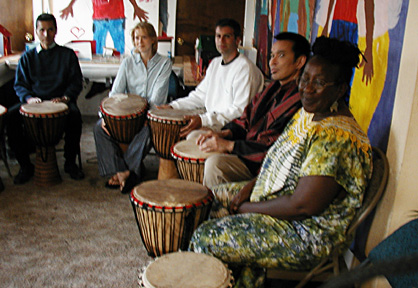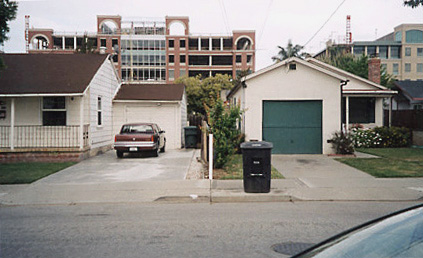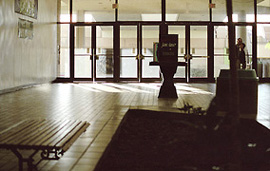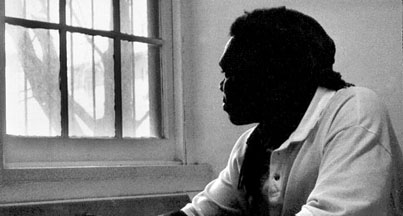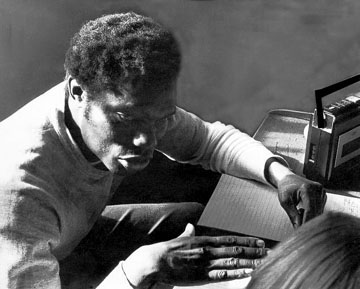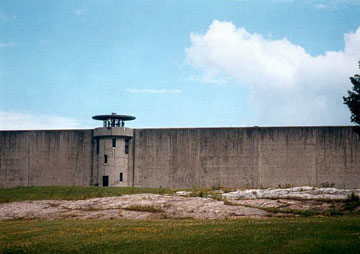It’s a part of Oakland the kids call ‘Ghosttown.’ They give various explanations for the name: bad things happen here; the streets are vacant, without the hum of thriving businesses; the black people who walk the streets at night look like ghosts. In other words, West Oakland isn’t exactly a destination. Cars may pass through here, but they stick to the interstate freeways along the edges of the neighborhood.
The corner of 33rd and West, however, is a different story. Here, in a duplex that used to be a crack house, the Attitudinal Healing Connection has opened up shop. On any given day, this non-profit community center is a hub of activity. People are constantly going in and out of the front door for after-school art programs or around back to check on their squash in the garden.
The AHC, simply put, is a nontraditional arts center, a school where you can take classes in painting, photography, and African drumming. But it is much more than that. It is a local effort in a national movement called attitudinal healing, which seeks to help people find inner peace by changing their attitudes toward personal problems. It is the most passionate of personal crusades—one family’s effort to transform a blighted city neighborhood, one heart at a time.
Whatever optimistic energy the center exudes, it has apparently been contagious. Near the house, where bougainvillea climbs up the porch posts and young trees sprout out of recently laid sidewalk, the neighbors have been cleaning up their property, too. All this fixing of fences and planting in yards to keep up with the Joneses.
Or, the Clotteys, to be exact.
Before we came here, it was like a Third World country,” says Kokomon Clottey, who opened the AHC in this neighborhood in 1994 with his wife Aeeshah and Aeeshah’s daughter Amana Harris. He points to the house across the street. “In 1994, that house didn’t sleep. They were always drinking or selling drugs. There was always the TV, partying, friends, cars—all kinds of madness.”
A white family, the Belknaps, used to own the house. Though it had a security system and bars on the windows, people still raided the house easily, even hauling a refrigerator out the front door once. The Belknaps were desperate to sell it. They even offered to loan the Clotteys the $10,000 needed for purchase and renovation if the Clotteys would use it for their arts center and live above it. The Clotteys were hesitant at first; it didn’t help that a man was killed across the street as they were considering the deal. But finally they decided they couldn’t refuse the opportunity to get to work in a neighborhood that so needed change.
Eight years later, the Clotteys have not only survived their stay in Ghosttown, but their center has thrived and its offerings have greatly expanded. These days Oakland residents can participate in a variety of programs that include a well-known racial healing circle, an ArtEsteem after-school program for children, after-school mentoring, and personal development retreats that can be counted for credit in some educational and vocational programs. The center’s staff also visits local schools on occasion, where they put on assemblies mixing together storytelling and African drumming.
In those eight years a lot has changed in the neighborhood, too. Prostitutes used to walk the streets nearby, but after Aeeshah insisted on inviting them in to sit for a spell, no one dares to troll for business in front of the AHC. The house also hasn’t been robbed since they moved in—even though the Clotteys have forgotten to lock their doors several times. Once Aeeshah left her purse on the back step and someone brought it around the next day with the contents untouched.
Above the center’s entrance is a saying that sums up the general attitude: “Expect a miracle.”
“The center has a lot to do with pulling the community together. People go into the garden to pick fruits and vegetables. It’s much quieter now and people seem friendlier,” says Robert Ervin, who lives right behind the AHC on 33rd Street. When he moved here in 1990, Ervin says the neighborhood was “pretty raunchy,” with drug dealing and other crimes taking place in the open. But now, he says, “We’re more of a community.”
Lucille Walker, who lives two doors down from the center, plants tomatoes in the AHC’s Forgiveness Garden. Since she arrived in 1973, Walker has seen the neighborhood go through a lot of changes—but nothing, she says, like what has happened since the AHC moved in. A woman of few words, she pats Kokomon on the shoulder, saying, “Since you’ve been here, everything’s been real nice.”
The AHC is an unusually successful example of a community-based program, says Breonna Cole, a nonprofit consultant. “What makes this place very different from other nonprofits that I work with is the ethos that they work from,” she explains. “They’re not afraid to be spiritual and pull together the pieces. This is evident in the work they do, especially the racial healing circle, which seems to benefit especially white people in asking what each of us brings to the table.”
Many city officials, including Oakland Mayor Jerry Brown, have commended the center’s efforts. “The AHC’s programs have clear goals and are open to all Oaklanders,” Brown writes in an endorsement letter. “Their approach is innovative and their programs are sorely needed in the communities they serve.”
A Course in Miracles
I visit on one summer afternoon, to check out for myself exactly what’s so “innovative” about the center. Kokomon takes me around back. “We don’t put a padlock on this gate,” he says as he leads me into the Forgiveness Garden. “We want people to feel welcome and to come help us.” It’s clear, by the look of the place, that the people are coming. Tomatoes, squash, and peppers sprout everywhere. Children have painted portraits of heroes such as Mahatma Gandhi and Congresswoman Barbara Lee on stacks of tires.
As we sit down on chairs built by the East Bay Conservation Corps, Kokomon explains the nontraditional mental health principles behind the work that he, Aeeshah, Amana, and their volunteers do. There are twelve principles of attitudinal healing, he explains, that flow from a book by Helen Shucman, A Course in Miracles, as well as psychiatric research by Jerry Jampolsky. Almost three decades ago, Jampolsky found that children with catastrophic illnesses improved when they changed their mental outlook. Attitudinal healers believe that we are not only responsible for our thoughts, but also for the feelings we experience. Our pain stems from our own thoughts, guilt, and judgments about people, experiences, and events. By exploring these feelings, and coming to terms with them, we can eventually heal them and find inner peace.
“It’s easy to point a finger and say B did that to me. But if you hold onto this, you don’t feel good. You won’t feel well. You have to be responsible for your thoughts and your own feelings,” Kokomon says.
The Clotteys’ contribution has been to take this specific message of love, forgiveness, and the need to let go of fear, and to apply it to the problem of racial healing. “It’s easy to say, ‘Hey, I’m poor,'” Kokomon says. “What are you going to do about poverty? Yes, the government did this to you, but are you going to sit there and let the government put madness on you the rest of your life? If you eat food that is not good for you, it will make you sick. You are responsible.”
Kokomon and Aeeshah make shared stories the cornerstone of the monthly racial healing circles. “Many times we don’t know each others’ stories because we’re afraid of being the recipient of fear, rage, guilt, or shame,” Aeeshah says. Because conversations on race can be incendiary, she believes we must start racial dialogue by connecting all the people in the room through a common ritual. This is the reason that the Clotteys begin their circles with drumming and a reading of ground rules of respect.
“That puts us all on the same page, with the same rhythm,” Aeeshah explains. Adjusting everyone’s sense of rhythm—which affects not just the way you keep a musical beat, but also the way you talk and walk—is important to creating an expressive, honest atmosphere, the Clotteys believe. It brings all of the participants into the space of the room from the various places they have come from and untangles them from their everyday uncertainties—what Kokomon calls the “tapestry of madness and fear.” As he explains: “When we’re in trouble, our rhythm changes. Mindful drumming is about letting go of stress and putting the body, mind, and spirit in alignment. Then, we are really ready.”
This basic work of talking, listening, and (literally) harmonizing with each other, the Clotteys believe, can ultimately heal racism. “You can’t legislate people learning to accept each other,” says Aeeshah. “That requires heart work.”
“We define racism as a life-threatening disease,” Kokomon says emphatically. “It’s killing people. We don’t want to wait until people are dying, but try to take a different angle, with prevention. This is for the people who are living so they don’t get to that point.”
According to Kokomon, committed participants of their racial healing circles have made lasting changes in their lives. White people especially respond to the circles, often working out guilt about their privileged pasts. In their book Beyond Fear, Aeeshah and Kokomon recount the story of Gerd, a German-born engineer who spent many years in Liberia. As he was mourning his status as a childless and single older man, he woke up to the realization that he had fathered a mixed-race daughter in Liberia whom he had turned his back on, more than three decades earlier. “Now, all I have of her are two pictures and three strings of beads—a very personal souvenir of her mother and a whole new way of hearing the country song ‘I’m in love with you, baby, and I don’t even know your name,'” Gerd says in the book. He started searching for his daughter, putting together a computer picture of what she would have looked like at thirty-four years of age. To the Clotteys, Gerd’s story shows the timelessness of all things and the need to face the past to move on into the future. They write: “He spoke of learning more about love and forgiveness in the last few months than in the previous fifty-eight years of his life. He is now actively involved in human rights work in Liberia, with the understanding that Africa is a deeply personal matter for everyone and that every human being is someone else’s daughter or son and deserves love, attention, and respect.”
Though Aeeshah and Kokomon insist their methods have achieved tangible results, it’s also easy to see how people might respond to their unconventional beliefs with skepticism. I raise my doubts with Kokomon at one point. “Spacey? People think it’s more than spacey,” he says. “They often think it’s a cult.” He laughs; it’s hard to think of Kokomon Clottey as an evangelical zealot. Even though he and Aeeshah and Amana live by these twelve principles and hope others will live by them, too, they say their work isn’t about indoctrination. “There’s a difference between being spiritual and being religious or dogmatic,” Kokomon says. “If you’re dogmatic you separate people. We’re nonpolitical and include everyone and everybody.” In his view, the principles of attitudinal healing are nothing more than ground rules for human decency in people’s everyday lives. “We just want to give them tools to improve their life. That might just be planting tomatoes in the garden.”
Amana sees their outside-the-box thinking as an advantage in these times. “Traditional methods and standard thinking are not working for our kids. They’re not living in standard homes. The question is how we support children for these conditions,” she says.
Once they get to know what really goes on at the center, parents seem to support the Clotteys’ methods. Anthony Hall said he hesitated before sending his eight-year-old daughter Kenya to the AHC because he worried that its nontraditional principles had something to do with cult-like behavior. But he eventually came around. “The AHC’s principles are humanistic. They don’t contradict our Christianity,” he says.
Interestingly, both Aeeshah and Kokomon grew up in Christian households—Aeeshah in small-town Louisiana and Kokomon in Gamashie, Ghana. It took them time to come around to attitudinal healing. Aeeshah’s early frustration with the racism she felt as a student at the University of California at Berkeley led her to the Nation of Islam in her search for racial uplift and support. But after seven years with that black nationalist group, she wasn’t sure she had found the answers to her questions. “I had an enormous amount of love in my heart,” she writes in Beyond Fear. “However, it was only shared with a portion of people on earth, and I added to my confusion by teaching this lesson to others. I taught love and fear.” Then Aeeshah attended a seminar where she was introduced to Helen Shucman’s book, A Course in Miracles. She suddenly felt as if she had found her spiritual path. She headed next to Tiburon, California, to meet with psychiatric researcher Jerry Jampolsky, and decided then that she was going to begin a new line of work.
Aeeshah introduced Kokomon to the ideas of attitudinal healing in 1990, as the two of them were collaborating on a tape of spiritual poetry set to African drumming. Kokomon, who was born in Gamashie as a member of the Ga-Adabe people and came to America as a musician in 1977, soon found that the principles of attitudinal healing resonated with the experiences of his own life—in particular his encounters with American racism. He brings all his talents to his work at the center, weaving the principles of attitudinal healing into what he has learned as a medicine man, modern interpreter of the Ga-Adabe’s wisdom and rituals, and master drummer.
Right now, the AHC keeps going through the full-time efforts of Kokomon, Amana, and several dedicated volunteers. Aeeshah’s salary as an assistant program director at Casa de la Vida, a residential psychiatric treatment center in Oakland, forms the basis of the center’s $100,000 annual budget. The AHC also receives substantial supplemental grants and some local contributions, but is still actively looking for other sources of income to expand their programs and their staffing.
Building a Better Oakland, One Popsicle Stick at a Time
In their version of West Oakland, the fish market is in-between the fire station and the senior living facility. A movie theater, bowling alley, pet store, and farm are near the AHC. Hoover Elementary School is on the next block, near the community garden, toy store, clothing shop, and arcade.
It’s a Friday afternoon, and I’m sitting in on a session of ArtEsteem, one of the AHC’s after-school programs. The twenty kids in attendance are busy building a community—one made from popsicle sticks, foam, paint, bits of wire mesh, and glue. These 3-D models are the culmination of fifteen weeks of learning about Oakland’s government, settlement history, sewage and water systems, demographics, and regional ecology under the guidance of ArtEsteem’s director, Amana Harris.
As part of their latest project, the children conducted videotape interviews with local residents, including a social worker, the owner of the liquor store on the corner, and a former drug dealer. After color-coding plots of West Oakland “beautiful,” “ugly,” or “interesting,” the kids decided what to keep, eliminate, or transform. It’s about allowing these kids to dream about a better life in the here and now, explains Kokomon. “We ask, ‘What do you want to do?’ now and plant the seeds. ‘Do you want to be a lawyer? Well, what does it take to be a lawyer? Work on it.'”
Even this little bit of daydreaming can be quite a luxury on the tough streets of Oakland. The city has already seen eighty-four murders this year; in 2001, there were eighty-seven murders. Drugs, prison, and materialism—and music that worships these things—are pervasive in children’s lives here. “The guys want to go to jail even if they’re from decent families,” Amana says. “Here, skills for boys are being able to count money, counting how many crack rocks you have, and standing on your feet for a long time.” While boys are running in the streets learning to be drug dealers, girls are shouldering the burdens of teen pregnancy.
“There are so many forces here that set kids up to fail,” Amana says. “It’s not like school gets closed down if there’s a shooting. Nobody’s really protected.”
That grim reality is all too clear to ten-year-old Tyrese Johnson. “People are already starting to do doughnuts,” says Tyrese, a veteran of the ArtEsteem program. “And there was a shooting near my school a year ago. I didn’t really want to walk home. I was afraid they’d start shooting again.”
Through painting, photography, and other creative outlets for their energies, ArtEsteem seeks to soothe the fears that afflict kids like Tyrese. “This climate is full of conflict,” says Amana. “It’s at school. They bring it over here. But we’re teaching them how to perceive negativity so it doesn’t penetrate them deeply.”
Program graduate Kamilah Craword says ArtEsteem changed her life. When she started attending sessions back in middle school, she had an “attitude” in class. “I was talking back, not doing what I was supposed to … I put all my negative energy on everybody in the class,” she wrote in one of the center’s newsletters. ArtEsteem helped Kamilah to get “back on track.” Now, rather than taking to the streets or sitting at home bored, she volunteers at the center almost every day. She helps Amana run ArtEsteem as the organization’s secretary, and swears by its effectiveness. “If this program wasn’t here I wonder where the kids would be right now. Would they be in jail? Would they be on drugs?”
Tyrese knows what he would be doing: “I’d be sitting at home, looking at the TV, getting fat. Or maybe riding around skating and stuff. But nothing artistic like this.” He gets very excited when talking about his favorite project, the kids’ larger-than-life portrait of themselves as superheroes saving West Oakland. “Super T,” he explains, has laser vision, super-strength, and, most importantly, “the power to change people’s minds, to make bad people good.” You could say that ArtsEsteem has had a similar effect on Tyrese. “I used to litter, but I don’t do it anymore,” he points out.
Breonna Cole, the nonprofit consultant, praises the AHC’s use of art to change children’s attitudes. The center, she says, has become a “place of last resort” for students who have been neglected by the school system. “The schools have no money or resources to invest in the kids,” she says. “The critical issue in Oakland public schools is that we have violence in schools and a disastrous lack of art.”
Parents also respond favorably to the program. Oakland resident and parent Anthony Hall says he particularly appreciates how ArtEsteem grounds art in the community, connecting the children to a larger sense of what it means to live in Oakland. “Here, the kids also develop friendships and relationships with other kids who are not going to the same school. They get to share common interests,” Hall says.
Kids who come to the program are sometimes labeled as troublemakers by their schools. Amana prefers to see them as “incredibly neglected, but full of love.” She has had to deal with so-called “kings of conflict” many times over the years, and under her close care, problem children often calm down and end up having perfect attendance. She remembers one boy who started out belligerent and, after she worked to win his trust, eventually confided in her, telling her in a note: “I need help.” But he later turned out to be too much for even Amana to handle. This boy’s defense mechanism, as she puts it, was “to be as offensive as can be,” and he would constantly antagonize the other kids. In the interest of keeping the program’s atmosphere as positive as possible, Amana had to expel him.
Amana herself grew up several blocks from where the AHC now has its office, and she still lives in the neighborhood with her husband and her daughter Sabah. The curriculum she is developing for ArtEsteem is part of her graduate work in multicultural education at the University of San Francisco’s Center for Teaching Excellence and Social Justice. Amana says she began working at the AHC because she wanted to put her art school degree and teaching background to work for the community. Her belief is that a program like ArtEsteem can help combat the negativity that she says is swallowing up young people.
At the end of each ArtEsteem class, Amana and the children join hands in a circle and observe a moment of silence. Then Amana leads the kids in their daily refrain: “We are a community. We support one another. We are willing to listen and learn and absorb all goodness as we breathe.” At the end of the circle, she asks, “Okay, who’s mature enough for extra responsibility?” If all goes well, everybody.
Skin on Skin
For an hour, no one in our circle of ten spoke. Kokomon’s hands kept moving, weaving in and out of different rhythms, leading us in the weekly Mindful Drumming session. Sometimes our fingers beat the skin of the handmade drums at a feverish pace; sometimes our palms just brushed the surfaces. We were a motley bunch—Latino construction workers seated alongside white and Asian American professionals, gay men jamming with straight women—but we were all keeping time together.
This was my first taste of the AHC’s programming. Much of the power of the center’s curriculum comes from the experience of the activities since, as one participant explained, they don’t aim at the head so much as the gut. So I wanted to make sure I’d taken part in at least one activity.
I was hesitant at first—mostly because I hadn’t ever participated in a drumming circle. But it turned out to be surprisingly easy—or perhaps surprisingly welcoming. There was a clarity to my thoughts as my hands drummed away. The action seemed to work out any nervousness or fatigue. I worried that my drumming sounded different from everyone else’s, but I came to appreciate that this was as it should be. Every set of hands produced a different sound; but we could be one orchestra, sharing one score. I noticed how individual each one of our hands were, yet they were made out of the same gristle and bone and had the same purpose. Hands make and remake constantly, in this way telling others that we exist. Wherever we had come from, whatever our story was, in this room, this evening, there was the fact of skin on skin.
I admit I had been skeptical about how much could be accomplished by sitting around a room beating on animal hide. But then I saw for myself the powerful effect that participating in a common activity and creating something collectively could have on people. After the drumming had ended, we sat in our circle and talked. People very openly shared how their weeks had gone. No one rolled their eyes, but listened with sincerity and patience. An hour of nonverbal expression had suddenly made the mouth and language seem like miraculous things.
Nothing shifted cataclysmically that night, but it seemed very possible that, if people kept coming, longtime frustrations could be vented, priorities reoriented, and habits changed. It seemed very possible that the Clotteys’ vision could come true. I felt much calmer leaving their house than when I had walked in. And stepping outside, I noticed the streets were also calm. A feeling of warmth and goodwill was palpable in the air.
In the distance, cars whizzed by on the freeways. Had their drivers stopped for a second to look toward West Oakland, they’d have seen that one street corner, 33rd and West, shone particularly bright.
- Follow us on Twitter: @inthefray
- Comment on stories or like us on Facebook
- Subscribe to our free email newsletter
- Send us your writing, photography, or artwork
- Republish our Creative Commons-licensed content

